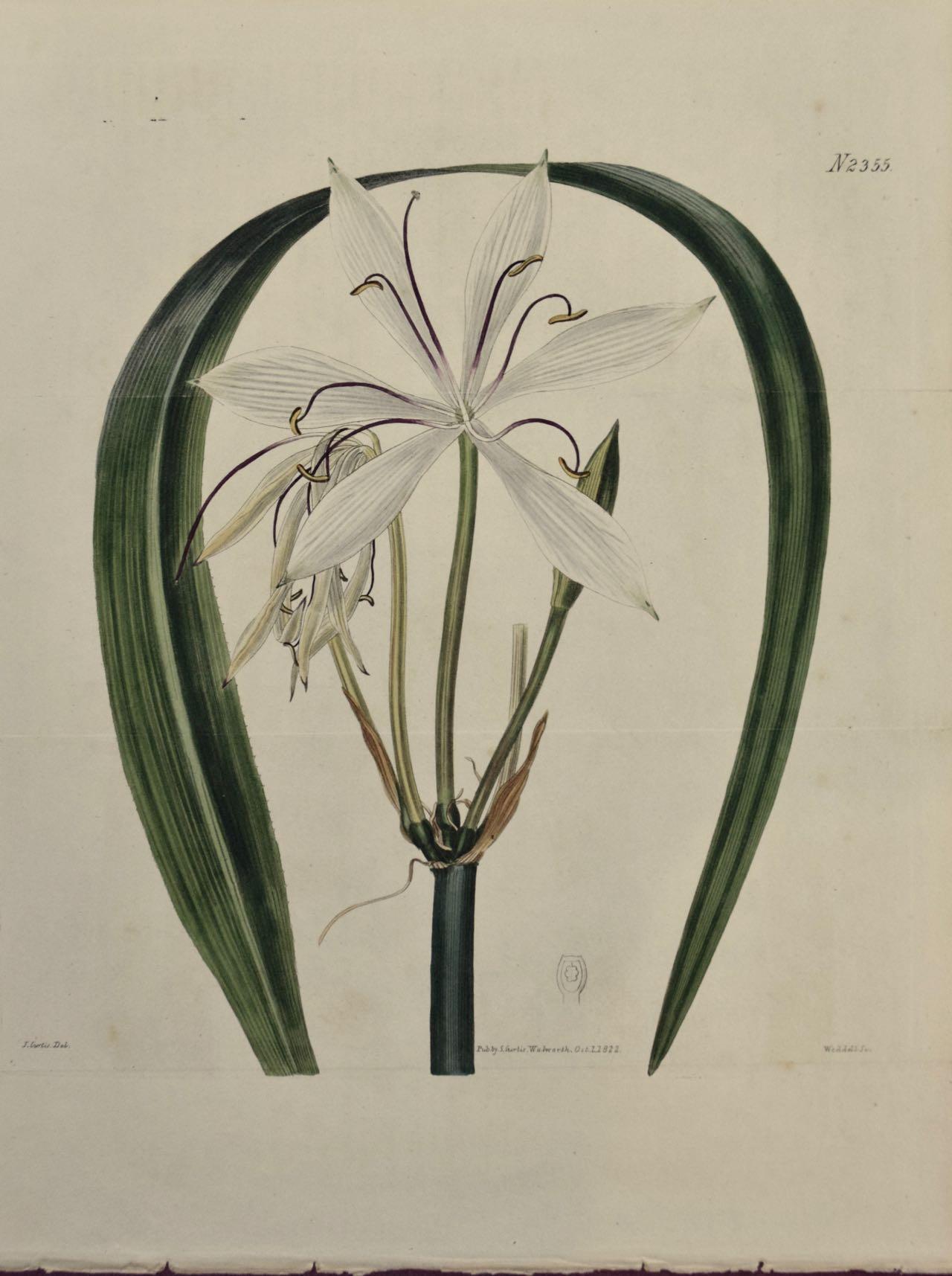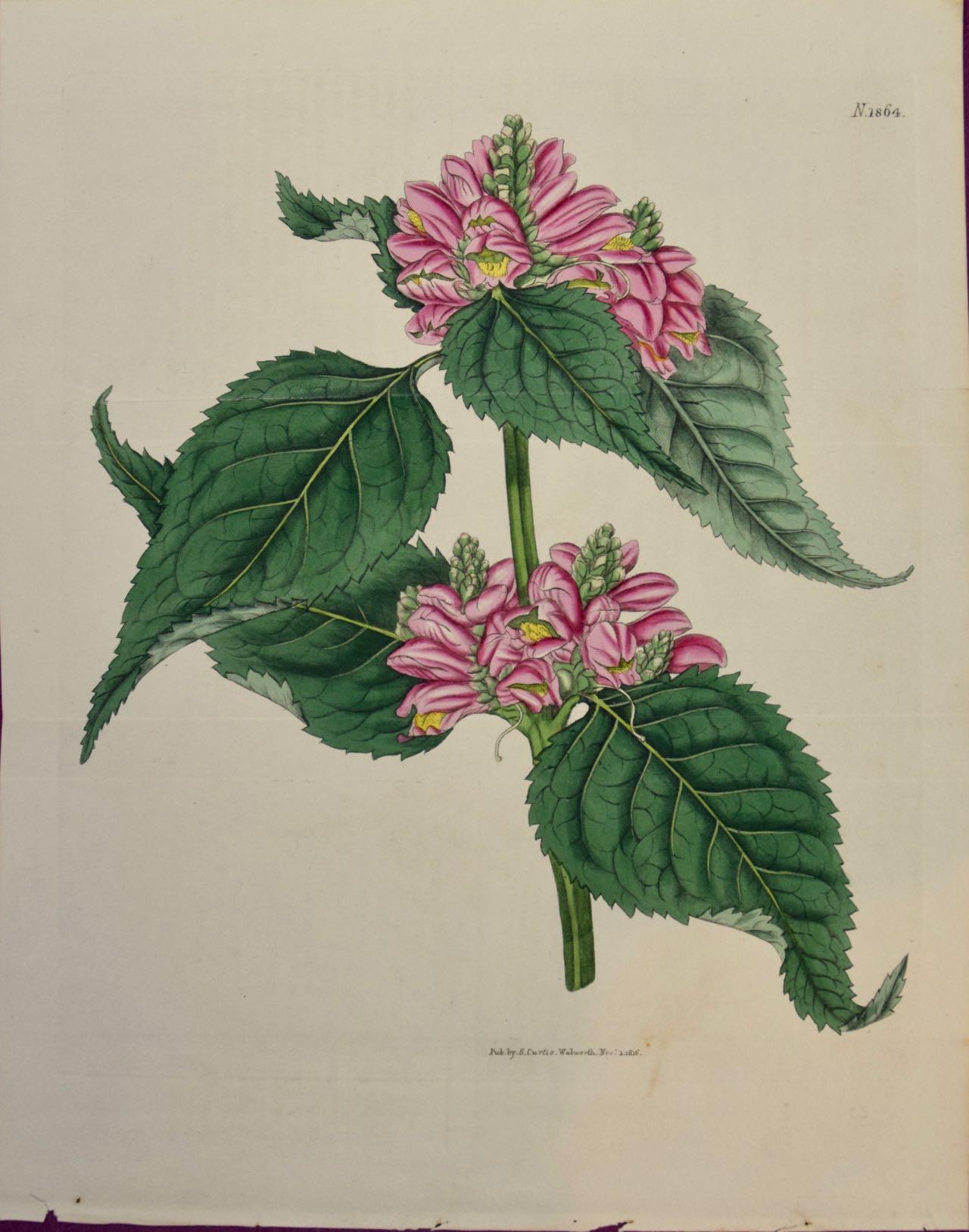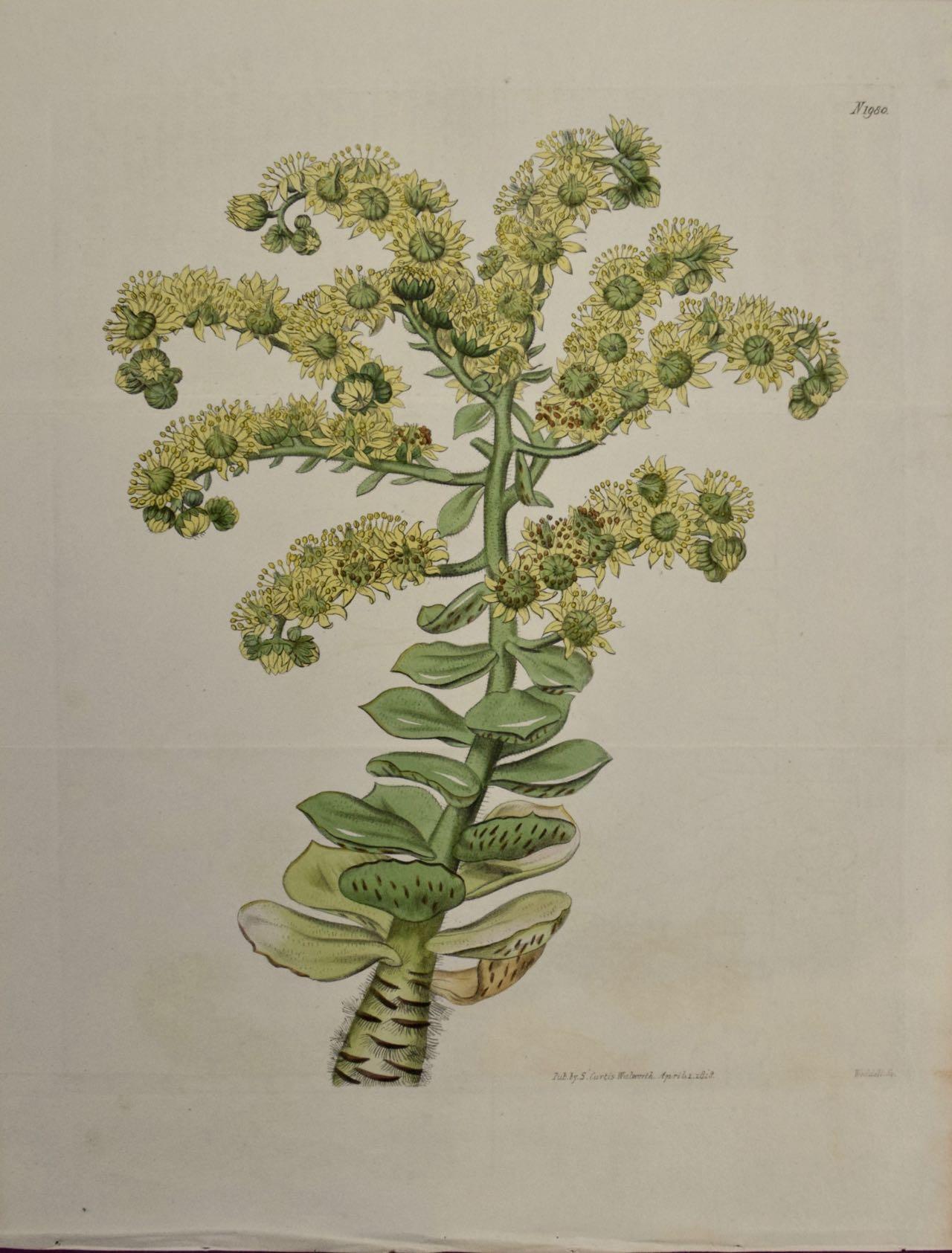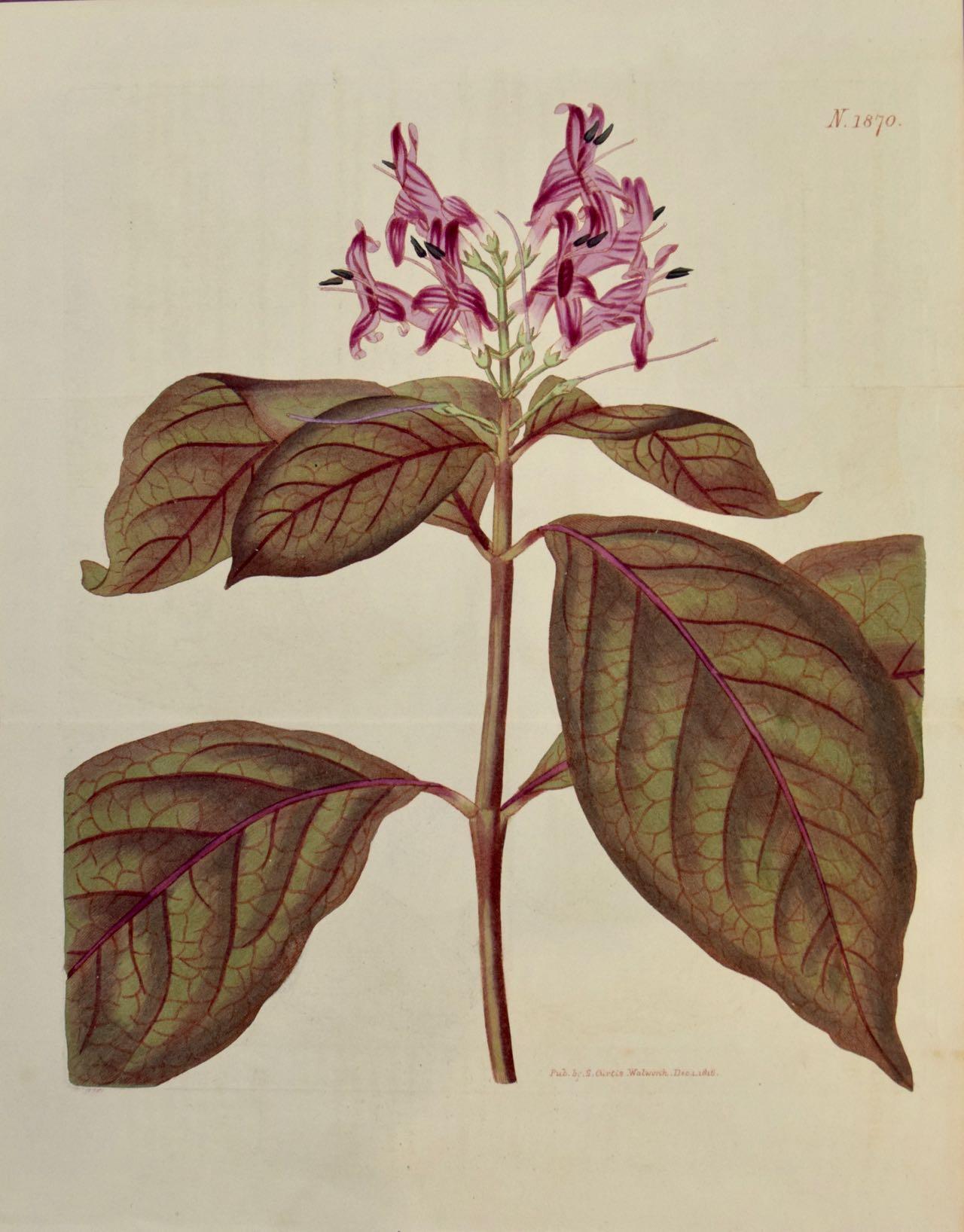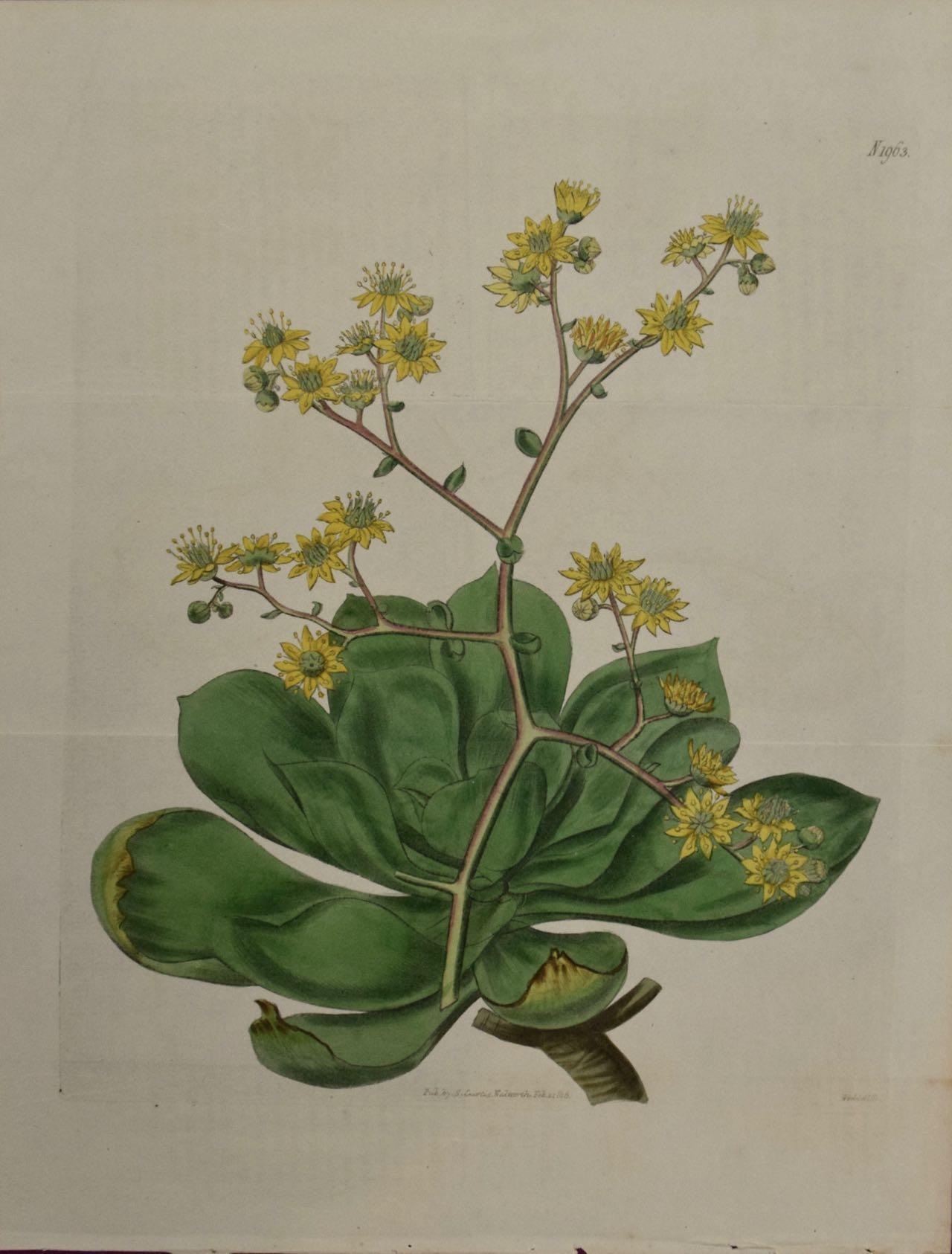Items Similar to Spear-leaved Helonias, Henry Andrews antique botanical flower engraving print
Want more images or videos?
Request additional images or videos from the seller
1 of 2
Henry C AndrewsSpear-leaved Helonias, Henry Andrews antique botanical flower engraving print1799
1799
About the Item
'Helonias bullata - Spear-leaved Helonias'
Native of Carolina, North America.
Original copper-line engraving with original hand-colouring from Henry Andrews' 'The Botanist's Repository', 1797-1812. Accompanied by the original descriptive text. 1799.
Henry Charles Andrews was an English botanist, botanical artist and engraver. He lived in Knightsbridge and was married to the daughter of John Kennedy of Hammersmith, a nurseryman who assisted Andrews in the descriptions of the plants he illustrated. Andrews was not only the artist, but also engraver, colourist, and publisher in an era when most artists were only employed to draw plates. The 'Botanist's Repository' was his first publication, issued serially in London in ten volumes between 1797 and 1812.
265mm by 210mm (sheet)
- Creator:Henry C Andrews (1770 - 1830)
- Creation Year:1799
- Dimensions:Height: 10.44 in (26.5 cm)Width: 8.27 in (21 cm)
- Medium:
- Movement & Style:
- Period:
- Condition:Creasing and stitching holes on far left edge of the sheet. Faint toning to the paper. A couple of tiny marks.
- Gallery Location:Melbourne, AU
- Reference Number:1stDibs: LU124428696962
About the Seller
5.0
Platinum Seller
These expertly vetted sellers are 1stDibs' most experienced sellers and are rated highest by our customers.
Established in 2005
1stDibs seller since 2019
442 sales on 1stDibs
Typical response time: <1 hour
- ShippingRetrieving quote...Ships From: Melbourne, Australia
- Return PolicyA return for this item may be initiated within 14 days of delivery.
More From This SellerView All
- Cape Atragene, Henry Andrews antique botanical pink flower engraving printBy Henry C AndrewsLocated in Melbourne, Victoria'Atragene Capensis - Cape Atragene' Native of the Cape of Good Hope. Original copper-line engraving with original hand-colouring from Henry Andrews' 'The Botanist's Repository', 1...Category
Early 19th Century Naturalistic Still-life Prints
MaterialsEngraving
- Columnar-chived Ixia, Henry Andrews antique botanical flower engraving printBy Henry C AndrewsLocated in Melbourne, Victoria'Ixia Columnaris - Columnar-chived Ixia' Native of Cape of Good Hope. Original copper-line engraving with original hand-colouring from Henry Andrews' 'The Botanist's Repository', ...Category
Early 19th Century Naturalistic Still-life Prints
MaterialsEngraving
- Peach varieties, fruit engraving with later hand-colouring, circa 1770By HL Duhamel Du MonceauLocated in Melbourne, VictoriaPeaches, Copper-line engraving with later hand-colouring, from Duhamel du Monceau’s 'Traité des Arbres Fruitiers', circa 1770. Duhamel du Monceau (1700-1782) was one of outstanding ...Category
18th Century Naturalistic Still-life Prints
MaterialsEngraving
- Azalea indica danielsiana, antique botanical pink flower engravingLocated in Melbourne, VictoriaEngraving with original hand-colouring. 1834. 230mm by 155mm. From Paxton's 'Magazine of botany and register of flowering plants' by Sir Joseph Paxton.Category
Mid-19th Century Naturalistic More Prints
MaterialsEngraving
- Petunia violacea, antique botanical purple flower engravingLocated in Melbourne, VictoriaEngraving with original hand-colouring. 1834. 230mm by 155mm. From Paxton's 'Magazine of botany and register of flowering plants' by Sir Joseph Paxton.Category
Mid-19th Century Naturalistic More Prints
MaterialsEngraving
- Streptanthera cuprea, antique botanical flower engravingLocated in Melbourne, VictoriaEngraving with original hand-colouring. 1834. 230mm by 155mm. From Paxton's 'Magazine of botany and register of flowering plants' by Sir Joseph Paxton.Category
Mid-19th Century Naturalistic More Prints
MaterialsEngraving
You May Also Like
- Redoute Hand-colored Engraving of Cactus Flowers "Cactus Peruvianus Cierge"By Pierre-Joseph RedoutéLocated in Alamo, CAThis framed hand-colored stipple engraving entitled "Cactus Peruvianus Cierge du Pérou" by Pierre-Joseph Redouté, Plate 58 from his illustrated publication 'Plantarum Historia Succulentarum ou Histoire des Plantes Grasses', published in Paris in 1799. It depicts a branching limb of a cactus with a beautiful flower. There is a separate detail of the anatomy of a seed with early growth. Redoute was a pioneer of the stipple engraving technique, which he used to create this image. It involves utilizing a series of small dots worked into a copper plate rather than the more common lines. These dots can be made smaller or thicker depending on the degree of opacity the artist intends for various areas of the print. When inked and applied to paper, this allows for a greater portion of the paper to be seen, which accentuates the appearance of luminosity of the subject the artist is creating. Different color inks are used in the printing process, a time consuming technique known as "a la poupee". The engraving is then finished with watercolor to further enhance the beauty and realism of the print subject. This engraving of a flowering cactus is presented in silver-colored ribbed wood frame and a double mat; cream-colored outer mat and heather green inner mat. The frame measures 21.25" high by 17.25" wide by 1.13" deep. The sheet measures 19.88" high by 14" wide. There are wide margins with a few short tears and chips along the the left, right and upper edges, which are all covered by the mat. There are small spots predominantly in the margins, with a few present in the image area. The print is otherwise in very good condition. There is another Redoute flowering cactus listed on 1stdibs, LU117326853392, which is framed and matted identically to this one. The pair would make an attractive display grouping. Pierre-Joseph Redouté (1759-1840), was a painter and botanist originally from Belgium, who pursued his extremely successful artistic career in France. He is well known for his watercolor paintings of roses, lilies and other flowers and their subsequent folio-sized, color stipple engravings. Some believe him to be the greatest botanical illustrator of all time. Redouté was a favorite of the French royal court at the time and of the post French...Category
Late 18th Century Naturalistic Still-life Prints
MaterialsEngraving
- Flowering Cactus: Redoute Hand-colored Engraving "Cactus Opuntia Polyanthos"By Pierre-Joseph RedoutéLocated in Alamo, CAThis hand colored stipple engraving entitled "Cactus Opuntia Polyanthos, Cierge Raquette Multiflore" by Pierre-Joseph Redouté, Plate 59 from his illustrated publication 'Plantarum Historia Succulentarum ou Histoire des Plantes Grasses', published in Paris in 1799. Redoute was a pioneer of the stipple engraving technique, which he used to create this image. It involves utilizing a series of small dots worked into a copper plate rather than the more common lines. These dots can be made smaller or thicker depending on the degree of opacity the artist intends for various areas of the print. When inked and applied to paper, this allows for a greater portion of the paper to be seen, which accentuates the appearance of luminosity of the subject the artist is creating. Different color inks are used in the printing process, a time consuming technique known as "a la poupee". The engraving is then finished with watercolor to further enhance the beauty and realism of the print subject. This engraving of a flowering cactus is presented in a double mat; white outer mat and heather green inner mat.The mat measures 20" x 16" and the sheet measures 19.5" x 13.38". There are wide margins with a few short tears and chips along the the right and upper edges, which are all covered by the mat. There are small spots predominantly in the margins, but a few are present in the image area, but the print is otherwise in very good condition. There is another Redoute flowering cactus listed on 1stdibs, LU117326854582. The pair would make an attractive display grouping. Pierre-Joseph Redouté (1759-1840), was a painter and botanist originally from Belgium, who pursued his extremely successful artistic career in France. He is well known for his watercolor paintings of roses, lilies and other flowers and their subsequent folio-sized, color stipple engravings. Some believe him to be the greatest botanical illustrator of all time. Redouté was a favorite of the French royal court at the time and of the post French...Category
Late 18th Century Naturalistic Still-life Prints
MaterialsEngraving
- "February Bouquet" from 'The Twelve Months of Flowers' series by Robert FurberBy Robert FurberLocated in Alamo, CAThis framed hand-colored engraving entitled "February Bouquet" is from 'The Twelve Months of Flowers' by Henry Furber, published in London in 1730 by Robert Sayer and John King. Each of the twelve hand-colored engravings in the book were produced from paintings by Pieter Casteels (1684-1749) and engraved by Henry Fletcher (1710-1753). The book featured twelve detailed engravings of seasonal plants in bloom in the form of a bouquet. More than 400 different species of flowering plants were included with each plant numbered and accompanied by a list of the corresponding species names. Thirty-five species of flowers are depicted in this engraving in a bouquet sitting in an ornate attractive bowl. A few of the flowers lie loose on a table. The flower species are listed in a table in the lower portion of the plate, along with the month that these flowers are in bloom. This colorful print is presented in a gold-colored wood frame with a cream-colored double mat with a heather green inner mat. The frame measures 23.5" x 19" x 1.63". There are a few small frame abrasions, but the print is in very good condition. Robert Furber...Category
Mid-18th Century Naturalistic Still-life Prints
MaterialsEngraving
- Asparagus: An 18th Century Hand-colored Botanical Engraving by J. WeinmannBy Johann Wilhelm WeinmannLocated in Alamo, CAThis colored botanical mezzotint and line engraving finished with hand coloring by Johann Wilhelm Weinmann (1683-1741) is entitled a. Thyrsus asparagi. b. Asparagus, Asperge. c. Aspa...Category
Mid-18th Century Naturalistic Still-life Prints
MaterialsEngraving, Mezzotint
- Weinmann 18th Century Hand Colored Botanical Engraving "Amaranthus seu Blitum"By Johann Wilhelm WeinmannLocated in Alamo, CAAn 18th century color printed in addition to hand colored botanical mezzotint and line engraving by Johann Wilhelm Weinmann (1683-1741) depicting the following flowering amaranthus p...Category
Mid-18th Century Naturalistic Still-life Prints
MaterialsEngraving, Mezzotint
- Weinmann 18th Century Hand Colored Botanical Engraving "Convolvulus" (Bindweed)By Johann Wilhelm WeinmannLocated in Alamo, CAThis is an 18th century hand-colored botanical mezzotint and line engraving by Johann Wilhelm Weinmann (1683-1741) depicting the following flowering bindweed plants: a. Convolvulus m...Category
Mid-18th Century Naturalistic Still-life Prints
MaterialsEngraving, Mezzotint
Recently Viewed
View AllMore Ways To Browse
Antique Original Engraving
Used Spears
Antique Flower Prints
Antique Flower Print
Antique Prints Of Flowers
Copper Engraving Plate
Antique Spears
Antique English Engraving
Antique Prints Flowers
Antique Print Of Flowers
Antique Copper Still
Antique Copper Stills
Copper Still Antique
Carolina Antique
Antique Botanical Originals
Antique Native American Prints
Flower Engravings Antique
Copper Flower Plate
